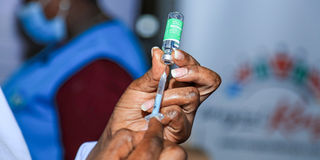It’s time Kenya government, including counties, invested more in immunization
Sponsored by African Population and Health Research Centre

By Reena Atuma
Vaccine invention is the greatest public health intervention and gift of science in the history of humankind.
Vaccines provide individuals and communities with the necessary immunity to prevent the outbreak of disease, avert a future disability and protect against other social and economic consequences of pandemics.
While there are great strides in developing vaccines to curb diseases, there are challenges experienced in financing for research, production, purchase, and administration of vaccines.
In Kenya, while devolution is a welcome development towards counties’ independence in decision-making on health matters, there is still a lack of information on immunization expenditure.
Counties provide little feedback to the Ministry of Health on the status of their devolved health systems. Therefore, they are not well coordinated with the objectives of the national government. Additional challenges include delayed release of funds, lack of innovative funding mechanisms, and absence of operational funding for implementing immunization services at the county levels.
According to the National Covid-19 Vaccines Deployment and Vaccination Plan for 2021, it costs the country Ksh6 billion to procure and distribute vaccines for routine immunization. Gavi contributes about Ksh3.8 billion or equivalent to 63 percent, and the Government 1.4 billion, equivalent to 23 percent. This leaves a resource gap of 13 percent or equivalent to Ksh0.8 billion.
The Covid-19 pandemic has not made the situation any better. The country is expected to procure vaccines for Covid-19 estimated at an indicative price of Ksh770 per dose. Using an estimation of 47 million Kenyans as per the population census of 2019, it would cost the government approximately Ksh72.38 billion to provide vaccines for the entire population for a double shot of Oxford-AstraZeneca, which is administered in two doses, four to 12 weeks apart.
The Government of Kenya is currently ensuring there is access to safe and effective Covid-19 vaccines to cover approximately 20 percent of the population, financed through the Gavi COVAX Facility, and is funding additional doses to cover another 10 percent of the population.
The Covid-19 Vaccines Global Access (COVAX) facility is a worldwide initiative to promote equitable access to Covid-19 vaccines, directed by Gavi, the Vaccine Alliance, the Coalition for Epidemic Preparedness Innovations, and the World Health Organisation.
In March this year, Kenya received just over one million doses of the Oxford-AstraZeneca Covid-19 vaccine as part of the COVAX Facility.
On May 28, the government kicked off the second round of vaccination exercises targeting healthcare workers, teachers, security personnel, and citizens aged 58 years and above.
As of June 2, 2021, Kenya had administered a total of 971,714 doses of Covid-19 vaccine.
Kenya will enter the accelerated transition out of Gavi in the FY 2022/23, with an expected exit in 2027. This means that the country will be expected to pay for the cost of vaccines added to the routine immunization schedule.
The Covid-19 pandemic exposed existing health system weaknesses in Kenya, including underfunding of the health sector. Additionally, routine immunization programmes were affected as all the focus by the government was on managing the pandemic.
Disease prevention interventions, such as vaccinations, generally achieve a good return on investment, and therefore the government must continue to invest in them.
The conversations around health financing and sustainability are gaining traction in Kenya within the broader context of universal health coverage (UHC).
The government should put in place policies and structures that will address the inadequate funding for the health sector.
Specifically for immunization, there is a need for the government to review the budget allocation for immunization services and increase funding.
County governments should also have a budget line for immunization and ensure that these funds are fully absorbed.
The writer is a Programmes Officer at the Institute of Public Finance Kenya


